SRM777 Construction Management Practices: Decision Making Tools Essay
VerifiedAdded on 2022/09/25
|9
|2188
|22
Essay
AI Summary
This essay explores the role of decision-making tools in construction projects, emphasizing their importance in meeting client demands and achieving project success. It provides an overview of various decision-making tools, including SWOT analysis, decision matrix, and others, highlighting the need for stakeholders to select the most appropriate tools based on project characteristics. The essay focuses on two specific tools: Pareto analysis and breakeven analysis. Pareto analysis is explained as a tool for identifying and prioritizing the most significant issues affecting a project, while breakeven analysis is presented as a method for assessing project financial status. The essay then delves into the practical application of Pareto charts in multi-story commercial projects, discussing how they can improve organizational efficiency, problem-solving abilities, and decision-making processes. The conclusion reiterates the significance of adapting to industry changes and emphasizes the utility of Pareto analysis in construction management.
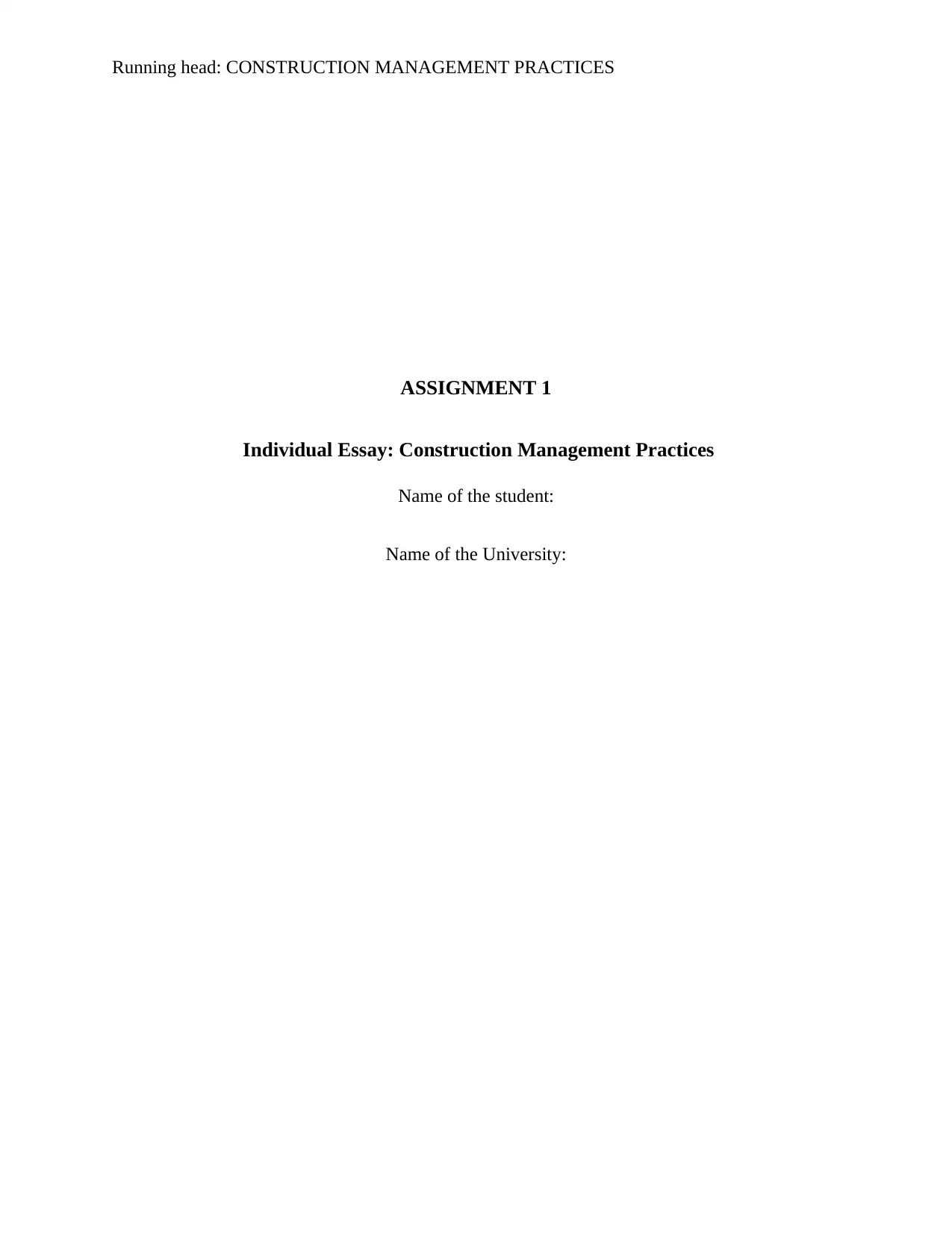
Running head: CONSTRUCTION MANAGEMENT PRACTICES
ASSIGNMENT 1
Individual Essay: Construction Management Practices
Name of the student:
Name of the University:
ASSIGNMENT 1
Individual Essay: Construction Management Practices
Name of the student:
Name of the University:
Paraphrase This Document
Need a fresh take? Get an instant paraphrase of this document with our AI Paraphraser
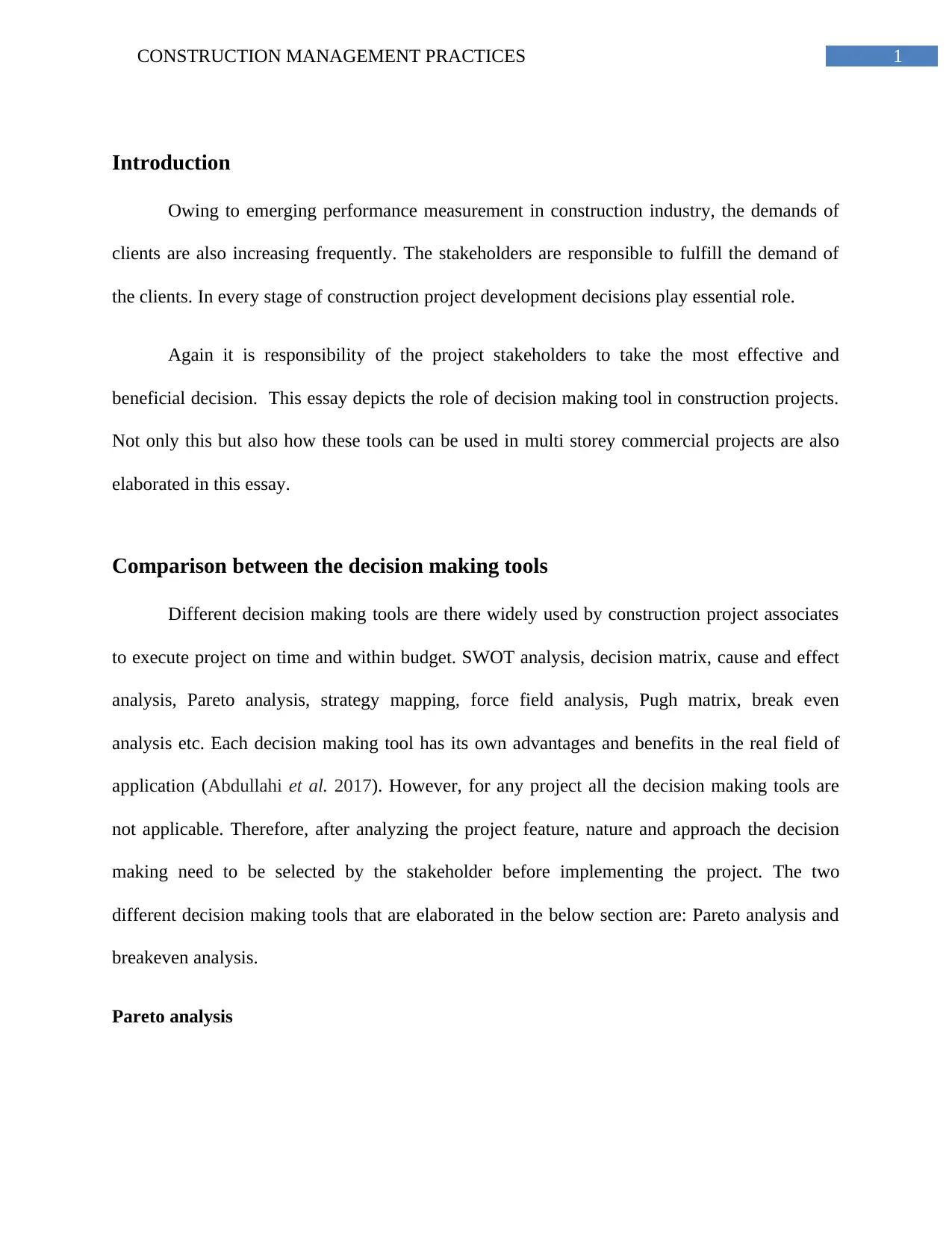
1CONSTRUCTION MANAGEMENT PRACTICES
Introduction
Owing to emerging performance measurement in construction industry, the demands of
clients are also increasing frequently. The stakeholders are responsible to fulfill the demand of
the clients. In every stage of construction project development decisions play essential role.
Again it is responsibility of the project stakeholders to take the most effective and
beneficial decision. This essay depicts the role of decision making tool in construction projects.
Not only this but also how these tools can be used in multi storey commercial projects are also
elaborated in this essay.
Comparison between the decision making tools
Different decision making tools are there widely used by construction project associates
to execute project on time and within budget. SWOT analysis, decision matrix, cause and effect
analysis, Pareto analysis, strategy mapping, force field analysis, Pugh matrix, break even
analysis etc. Each decision making tool has its own advantages and benefits in the real field of
application (Abdullahi et al. 2017). However, for any project all the decision making tools are
not applicable. Therefore, after analyzing the project feature, nature and approach the decision
making need to be selected by the stakeholder before implementing the project. The two
different decision making tools that are elaborated in the below section are: Pareto analysis and
breakeven analysis.
Pareto analysis
Introduction
Owing to emerging performance measurement in construction industry, the demands of
clients are also increasing frequently. The stakeholders are responsible to fulfill the demand of
the clients. In every stage of construction project development decisions play essential role.
Again it is responsibility of the project stakeholders to take the most effective and
beneficial decision. This essay depicts the role of decision making tool in construction projects.
Not only this but also how these tools can be used in multi storey commercial projects are also
elaborated in this essay.
Comparison between the decision making tools
Different decision making tools are there widely used by construction project associates
to execute project on time and within budget. SWOT analysis, decision matrix, cause and effect
analysis, Pareto analysis, strategy mapping, force field analysis, Pugh matrix, break even
analysis etc. Each decision making tool has its own advantages and benefits in the real field of
application (Abdullahi et al. 2017). However, for any project all the decision making tools are
not applicable. Therefore, after analyzing the project feature, nature and approach the decision
making need to be selected by the stakeholder before implementing the project. The two
different decision making tools that are elaborated in the below section are: Pareto analysis and
breakeven analysis.
Pareto analysis
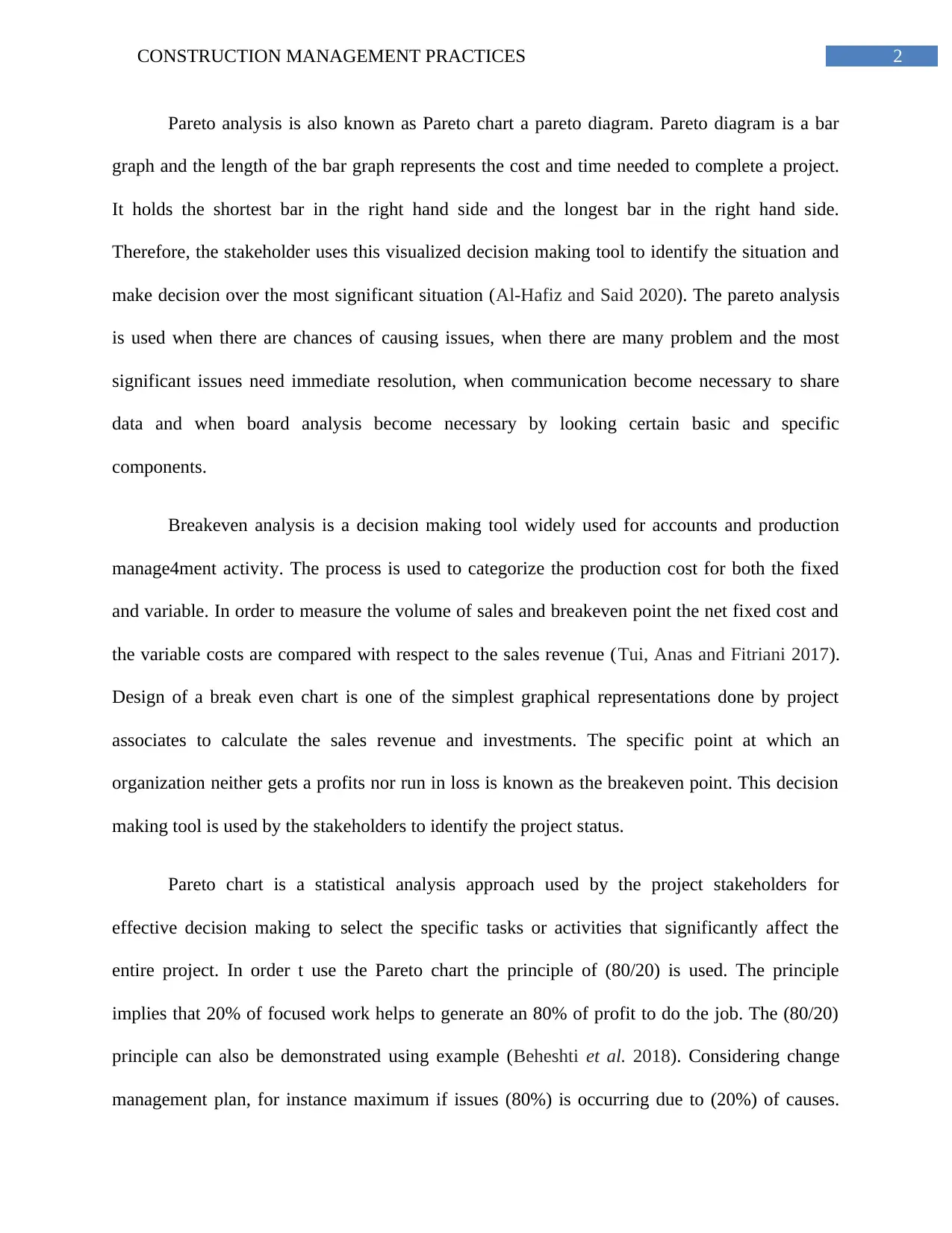
2CONSTRUCTION MANAGEMENT PRACTICES
Pareto analysis is also known as Pareto chart a pareto diagram. Pareto diagram is a bar
graph and the length of the bar graph represents the cost and time needed to complete a project.
It holds the shortest bar in the right hand side and the longest bar in the right hand side.
Therefore, the stakeholder uses this visualized decision making tool to identify the situation and
make decision over the most significant situation (Al-Hafiz and Said 2020). The pareto analysis
is used when there are chances of causing issues, when there are many problem and the most
significant issues need immediate resolution, when communication become necessary to share
data and when board analysis become necessary by looking certain basic and specific
components.
Breakeven analysis is a decision making tool widely used for accounts and production
manage4ment activity. The process is used to categorize the production cost for both the fixed
and variable. In order to measure the volume of sales and breakeven point the net fixed cost and
the variable costs are compared with respect to the sales revenue (Tui, Anas and Fitriani 2017).
Design of a break even chart is one of the simplest graphical representations done by project
associates to calculate the sales revenue and investments. The specific point at which an
organization neither gets a profits nor run in loss is known as the breakeven point. This decision
making tool is used by the stakeholders to identify the project status.
Pareto chart is a statistical analysis approach used by the project stakeholders for
effective decision making to select the specific tasks or activities that significantly affect the
entire project. In order t use the Pareto chart the principle of (80/20) is used. The principle
implies that 20% of focused work helps to generate an 80% of profit to do the job. The (80/20)
principle can also be demonstrated using example (Beheshti et al. 2018). Considering change
management plan, for instance maximum if issues (80%) is occurring due to (20%) of causes.
Pareto analysis is also known as Pareto chart a pareto diagram. Pareto diagram is a bar
graph and the length of the bar graph represents the cost and time needed to complete a project.
It holds the shortest bar in the right hand side and the longest bar in the right hand side.
Therefore, the stakeholder uses this visualized decision making tool to identify the situation and
make decision over the most significant situation (Al-Hafiz and Said 2020). The pareto analysis
is used when there are chances of causing issues, when there are many problem and the most
significant issues need immediate resolution, when communication become necessary to share
data and when board analysis become necessary by looking certain basic and specific
components.
Breakeven analysis is a decision making tool widely used for accounts and production
manage4ment activity. The process is used to categorize the production cost for both the fixed
and variable. In order to measure the volume of sales and breakeven point the net fixed cost and
the variable costs are compared with respect to the sales revenue (Tui, Anas and Fitriani 2017).
Design of a break even chart is one of the simplest graphical representations done by project
associates to calculate the sales revenue and investments. The specific point at which an
organization neither gets a profits nor run in loss is known as the breakeven point. This decision
making tool is used by the stakeholders to identify the project status.
Pareto chart is a statistical analysis approach used by the project stakeholders for
effective decision making to select the specific tasks or activities that significantly affect the
entire project. In order t use the Pareto chart the principle of (80/20) is used. The principle
implies that 20% of focused work helps to generate an 80% of profit to do the job. The (80/20)
principle can also be demonstrated using example (Beheshti et al. 2018). Considering change
management plan, for instance maximum if issues (80%) is occurring due to (20%) of causes.
⊘ This is a preview!⊘
Do you want full access?
Subscribe today to unlock all pages.

Trusted by 1+ million students worldwide
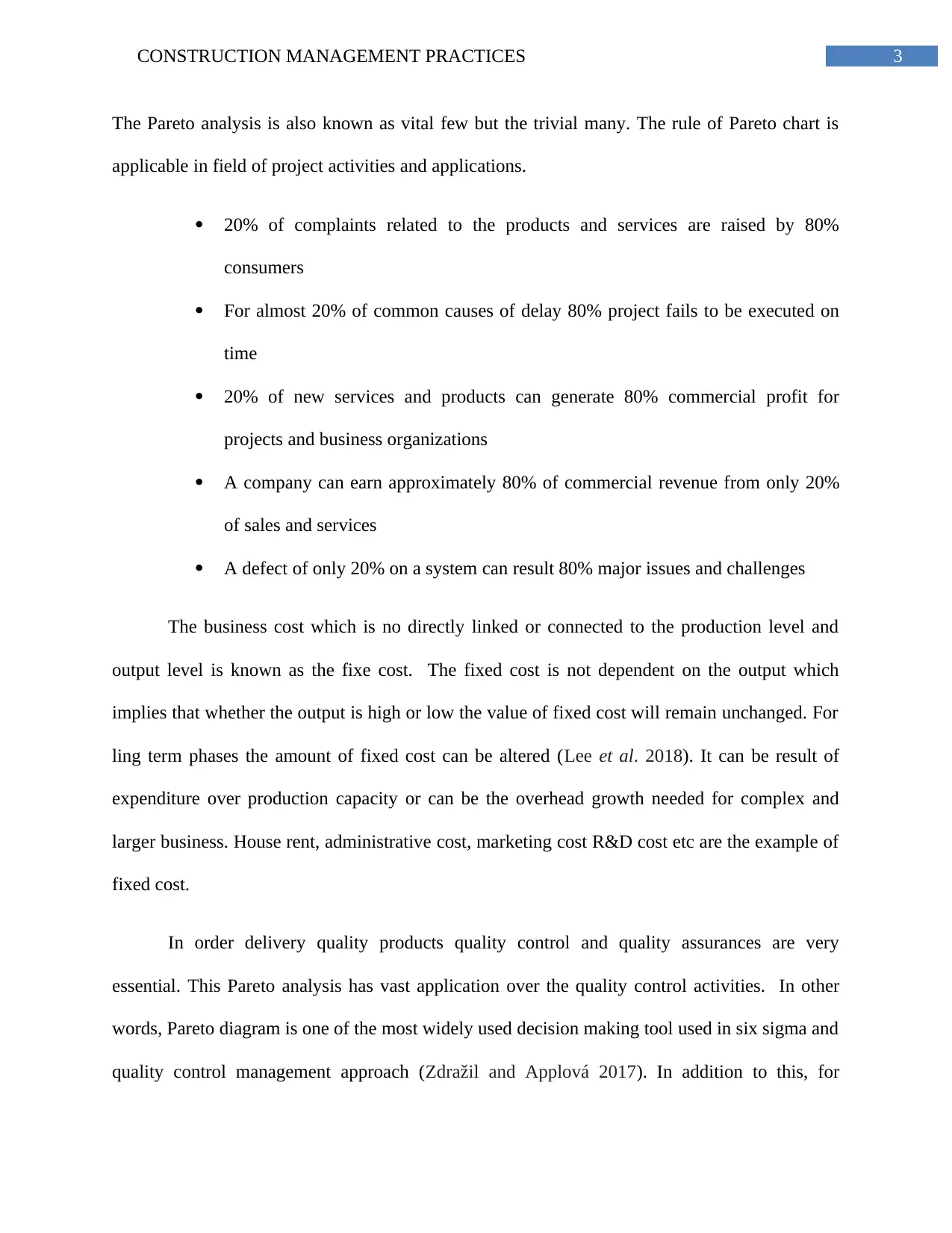
3CONSTRUCTION MANAGEMENT PRACTICES
The Pareto analysis is also known as vital few but the trivial many. The rule of Pareto chart is
applicable in field of project activities and applications.
20% of complaints related to the products and services are raised by 80%
consumers
For almost 20% of common causes of delay 80% project fails to be executed on
time
20% of new services and products can generate 80% commercial profit for
projects and business organizations
A company can earn approximately 80% of commercial revenue from only 20%
of sales and services
A defect of only 20% on a system can result 80% major issues and challenges
The business cost which is no directly linked or connected to the production level and
output level is known as the fixe cost. The fixed cost is not dependent on the output which
implies that whether the output is high or low the value of fixed cost will remain unchanged. For
ling term phases the amount of fixed cost can be altered (Lee et al. 2018). It can be result of
expenditure over production capacity or can be the overhead growth needed for complex and
larger business. House rent, administrative cost, marketing cost R&D cost etc are the example of
fixed cost.
In order delivery quality products quality control and quality assurances are very
essential. This Pareto analysis has vast application over the quality control activities. In other
words, Pareto diagram is one of the most widely used decision making tool used in six sigma and
quality control management approach (Zdražil and Applová 2017). In addition to this, for
The Pareto analysis is also known as vital few but the trivial many. The rule of Pareto chart is
applicable in field of project activities and applications.
20% of complaints related to the products and services are raised by 80%
consumers
For almost 20% of common causes of delay 80% project fails to be executed on
time
20% of new services and products can generate 80% commercial profit for
projects and business organizations
A company can earn approximately 80% of commercial revenue from only 20%
of sales and services
A defect of only 20% on a system can result 80% major issues and challenges
The business cost which is no directly linked or connected to the production level and
output level is known as the fixe cost. The fixed cost is not dependent on the output which
implies that whether the output is high or low the value of fixed cost will remain unchanged. For
ling term phases the amount of fixed cost can be altered (Lee et al. 2018). It can be result of
expenditure over production capacity or can be the overhead growth needed for complex and
larger business. House rent, administrative cost, marketing cost R&D cost etc are the example of
fixed cost.
In order delivery quality products quality control and quality assurances are very
essential. This Pareto analysis has vast application over the quality control activities. In other
words, Pareto diagram is one of the most widely used decision making tool used in six sigma and
quality control management approach (Zdražil and Applová 2017). In addition to this, for
Paraphrase This Document
Need a fresh take? Get an instant paraphrase of this document with our AI Paraphraser

4CONSTRUCTION MANAGEMENT PRACTICES
guiding the project team to take effective decision on fixing some major problems that are
resulting serious issues, the Pareto ordering is used.
Pareto analysis is an observation tool that helps to observe the roots of problems that are
occurring in ether projects or large business operations. The Pareto chart helps the project team
become focused on those investments that can generate maximum impact. The input and output
balance is clearly represented using this visualize format (Abdullahi et al. 2017). In order to
verify the changes processes and also to compare the before and after project snapshot Pareto
chart analysis play effective role. As a whole it can be said that using Pareto chart the status of a
project can be eventually improved a lot.
Breakeven analysis is a very advantageous decision making tool used by projects and
business operations. It helps to measure the amount of profit and loss in varied sales and
production level. It helps to predict the consequence of changing price of sales (Lee et al. 2018).
It helps to analyze the link and connection between the fixed cost and the variable cost. Not only
this but also, for predicting the effect of cost as well as efficiency of changes over profitability
are also measured with the help of breakeven analysis decision making tool.
Two different ways are there used to measure or calculate the breakeven point (Chibuzor
2018). In the first approach for every unit the fixed cost is divided, it will give the result per unit.
On the other hand, for the second approach, the fixed cost is divided based on contribution over
the sales ratio. Therefore, it can be said that Pareto analysis and breakeven analysis are two
completely different tools used for decision making.
Use of Pareto chart in Multi-storey commercial projects
guiding the project team to take effective decision on fixing some major problems that are
resulting serious issues, the Pareto ordering is used.
Pareto analysis is an observation tool that helps to observe the roots of problems that are
occurring in ether projects or large business operations. The Pareto chart helps the project team
become focused on those investments that can generate maximum impact. The input and output
balance is clearly represented using this visualize format (Abdullahi et al. 2017). In order to
verify the changes processes and also to compare the before and after project snapshot Pareto
chart analysis play effective role. As a whole it can be said that using Pareto chart the status of a
project can be eventually improved a lot.
Breakeven analysis is a very advantageous decision making tool used by projects and
business operations. It helps to measure the amount of profit and loss in varied sales and
production level. It helps to predict the consequence of changing price of sales (Lee et al. 2018).
It helps to analyze the link and connection between the fixed cost and the variable cost. Not only
this but also, for predicting the effect of cost as well as efficiency of changes over profitability
are also measured with the help of breakeven analysis decision making tool.
Two different ways are there used to measure or calculate the breakeven point (Chibuzor
2018). In the first approach for every unit the fixed cost is divided, it will give the result per unit.
On the other hand, for the second approach, the fixed cost is divided based on contribution over
the sales ratio. Therefore, it can be said that Pareto analysis and breakeven analysis are two
completely different tools used for decision making.
Use of Pareto chart in Multi-storey commercial projects
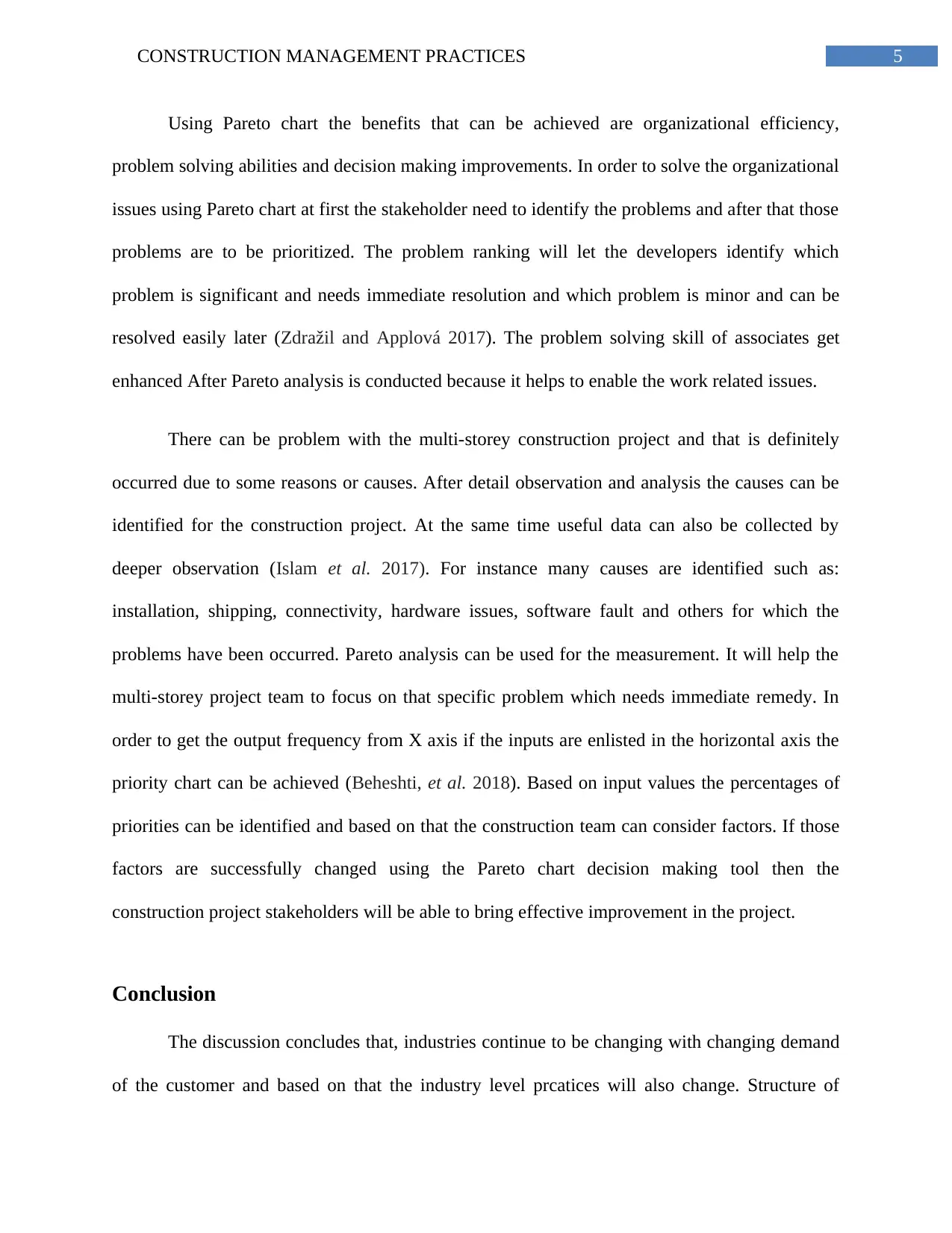
5CONSTRUCTION MANAGEMENT PRACTICES
Using Pareto chart the benefits that can be achieved are organizational efficiency,
problem solving abilities and decision making improvements. In order to solve the organizational
issues using Pareto chart at first the stakeholder need to identify the problems and after that those
problems are to be prioritized. The problem ranking will let the developers identify which
problem is significant and needs immediate resolution and which problem is minor and can be
resolved easily later (Zdražil and Applová 2017). The problem solving skill of associates get
enhanced After Pareto analysis is conducted because it helps to enable the work related issues.
There can be problem with the multi-storey construction project and that is definitely
occurred due to some reasons or causes. After detail observation and analysis the causes can be
identified for the construction project. At the same time useful data can also be collected by
deeper observation (Islam et al. 2017). For instance many causes are identified such as:
installation, shipping, connectivity, hardware issues, software fault and others for which the
problems have been occurred. Pareto analysis can be used for the measurement. It will help the
multi-storey project team to focus on that specific problem which needs immediate remedy. In
order to get the output frequency from X axis if the inputs are enlisted in the horizontal axis the
priority chart can be achieved (Beheshti, et al. 2018). Based on input values the percentages of
priorities can be identified and based on that the construction team can consider factors. If those
factors are successfully changed using the Pareto chart decision making tool then the
construction project stakeholders will be able to bring effective improvement in the project.
Conclusion
The discussion concludes that, industries continue to be changing with changing demand
of the customer and based on that the industry level prcatices will also change. Structure of
Using Pareto chart the benefits that can be achieved are organizational efficiency,
problem solving abilities and decision making improvements. In order to solve the organizational
issues using Pareto chart at first the stakeholder need to identify the problems and after that those
problems are to be prioritized. The problem ranking will let the developers identify which
problem is significant and needs immediate resolution and which problem is minor and can be
resolved easily later (Zdražil and Applová 2017). The problem solving skill of associates get
enhanced After Pareto analysis is conducted because it helps to enable the work related issues.
There can be problem with the multi-storey construction project and that is definitely
occurred due to some reasons or causes. After detail observation and analysis the causes can be
identified for the construction project. At the same time useful data can also be collected by
deeper observation (Islam et al. 2017). For instance many causes are identified such as:
installation, shipping, connectivity, hardware issues, software fault and others for which the
problems have been occurred. Pareto analysis can be used for the measurement. It will help the
multi-storey project team to focus on that specific problem which needs immediate remedy. In
order to get the output frequency from X axis if the inputs are enlisted in the horizontal axis the
priority chart can be achieved (Beheshti, et al. 2018). Based on input values the percentages of
priorities can be identified and based on that the construction team can consider factors. If those
factors are successfully changed using the Pareto chart decision making tool then the
construction project stakeholders will be able to bring effective improvement in the project.
Conclusion
The discussion concludes that, industries continue to be changing with changing demand
of the customer and based on that the industry level prcatices will also change. Structure of
⊘ This is a preview!⊘
Do you want full access?
Subscribe today to unlock all pages.

Trusted by 1+ million students worldwide
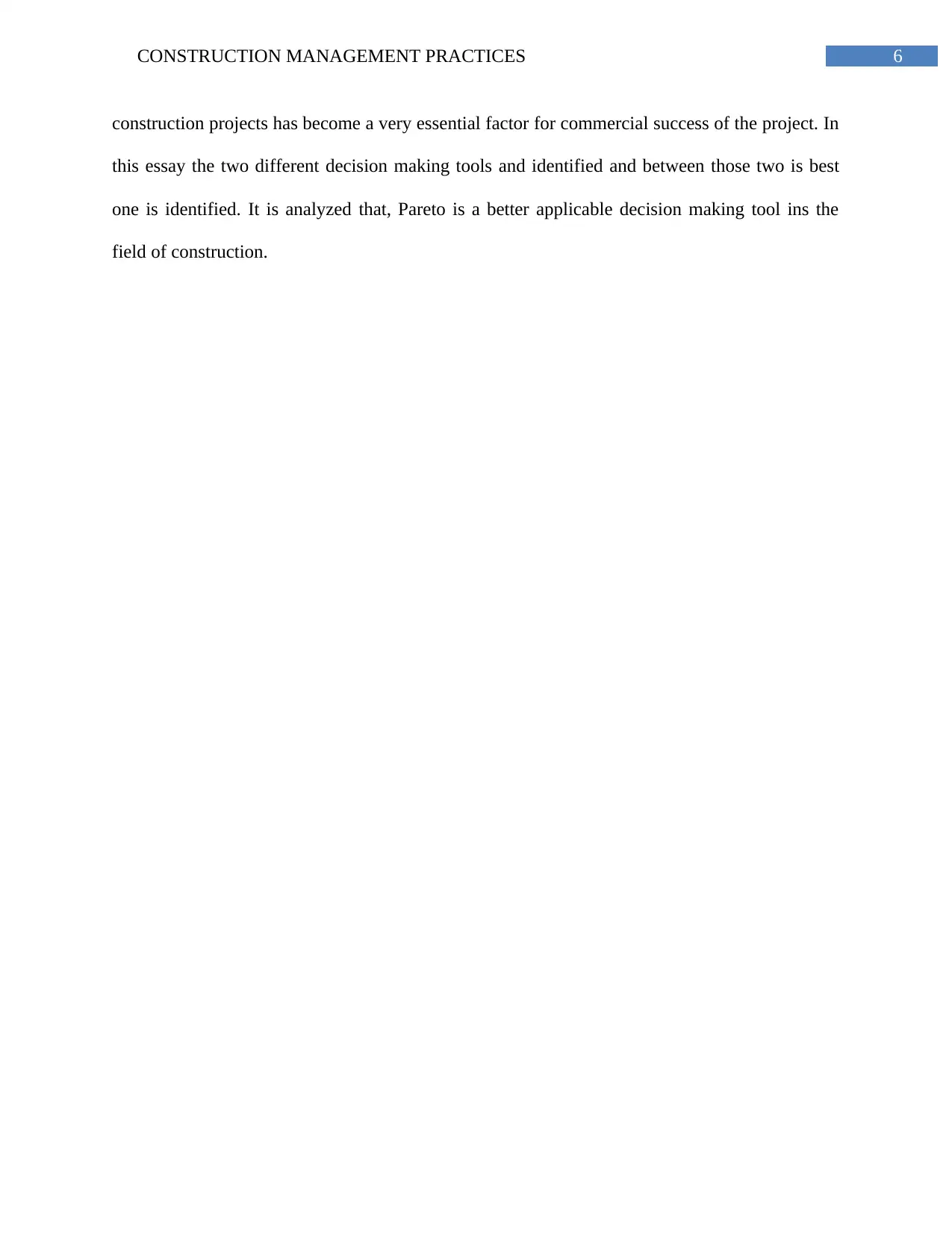
6CONSTRUCTION MANAGEMENT PRACTICES
construction projects has become a very essential factor for commercial success of the project. In
this essay the two different decision making tools and identified and between those two is best
one is identified. It is analyzed that, Pareto is a better applicable decision making tool ins the
field of construction.
construction projects has become a very essential factor for commercial success of the project. In
this essay the two different decision making tools and identified and between those two is best
one is identified. It is analyzed that, Pareto is a better applicable decision making tool ins the
field of construction.
Paraphrase This Document
Need a fresh take? Get an instant paraphrase of this document with our AI Paraphraser
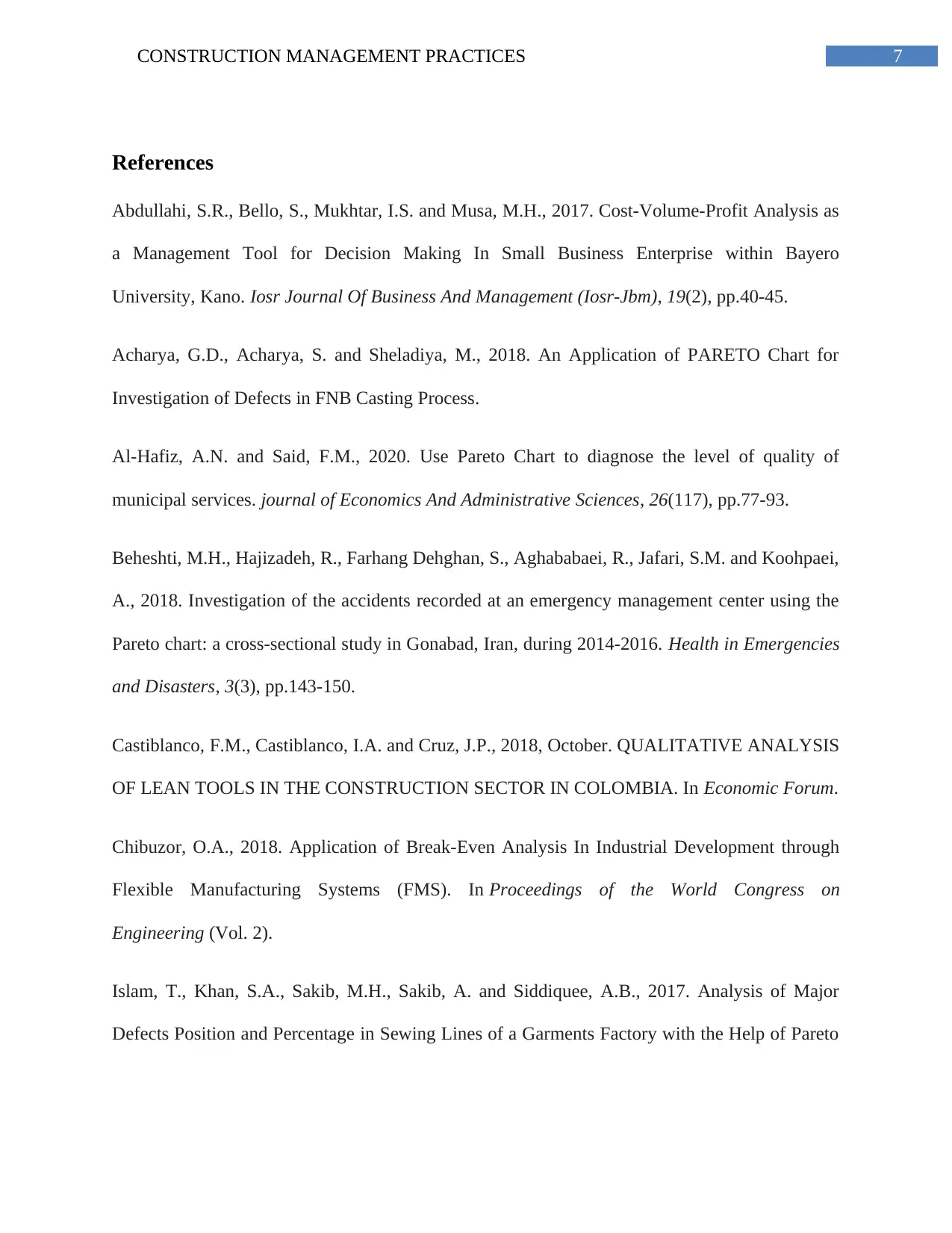
7CONSTRUCTION MANAGEMENT PRACTICES
References
Abdullahi, S.R., Bello, S., Mukhtar, I.S. and Musa, M.H., 2017. Cost-Volume-Profit Analysis as
a Management Tool for Decision Making In Small Business Enterprise within Bayero
University, Kano. Iosr Journal Of Business And Management (Iosr-Jbm), 19(2), pp.40-45.
Acharya, G.D., Acharya, S. and Sheladiya, M., 2018. An Application of PARETO Chart for
Investigation of Defects in FNB Casting Process.
Al-Hafiz, A.N. and Said, F.M., 2020. Use Pareto Chart to diagnose the level of quality of
municipal services. journal of Economics And Administrative Sciences, 26(117), pp.77-93.
Beheshti, M.H., Hajizadeh, R., Farhang Dehghan, S., Aghababaei, R., Jafari, S.M. and Koohpaei,
A., 2018. Investigation of the accidents recorded at an emergency management center using the
Pareto chart: a cross-sectional study in Gonabad, Iran, during 2014-2016. Health in Emergencies
and Disasters, 3(3), pp.143-150.
Castiblanco, F.M., Castiblanco, I.A. and Cruz, J.P., 2018, October. QUALITATIVE ANALYSIS
OF LEAN TOOLS IN THE CONSTRUCTION SECTOR IN COLOMBIA. In Economic Forum.
Chibuzor, O.A., 2018. Application of Break-Even Analysis In Industrial Development through
Flexible Manufacturing Systems (FMS). In Proceedings of the World Congress on
Engineering (Vol. 2).
Islam, T., Khan, S.A., Sakib, M.H., Sakib, A. and Siddiquee, A.B., 2017. Analysis of Major
Defects Position and Percentage in Sewing Lines of a Garments Factory with the Help of Pareto
References
Abdullahi, S.R., Bello, S., Mukhtar, I.S. and Musa, M.H., 2017. Cost-Volume-Profit Analysis as
a Management Tool for Decision Making In Small Business Enterprise within Bayero
University, Kano. Iosr Journal Of Business And Management (Iosr-Jbm), 19(2), pp.40-45.
Acharya, G.D., Acharya, S. and Sheladiya, M., 2018. An Application of PARETO Chart for
Investigation of Defects in FNB Casting Process.
Al-Hafiz, A.N. and Said, F.M., 2020. Use Pareto Chart to diagnose the level of quality of
municipal services. journal of Economics And Administrative Sciences, 26(117), pp.77-93.
Beheshti, M.H., Hajizadeh, R., Farhang Dehghan, S., Aghababaei, R., Jafari, S.M. and Koohpaei,
A., 2018. Investigation of the accidents recorded at an emergency management center using the
Pareto chart: a cross-sectional study in Gonabad, Iran, during 2014-2016. Health in Emergencies
and Disasters, 3(3), pp.143-150.
Castiblanco, F.M., Castiblanco, I.A. and Cruz, J.P., 2018, October. QUALITATIVE ANALYSIS
OF LEAN TOOLS IN THE CONSTRUCTION SECTOR IN COLOMBIA. In Economic Forum.
Chibuzor, O.A., 2018. Application of Break-Even Analysis In Industrial Development through
Flexible Manufacturing Systems (FMS). In Proceedings of the World Congress on
Engineering (Vol. 2).
Islam, T., Khan, S.A., Sakib, M.H., Sakib, A. and Siddiquee, A.B., 2017. Analysis of Major
Defects Position and Percentage in Sewing Lines of a Garments Factory with the Help of Pareto
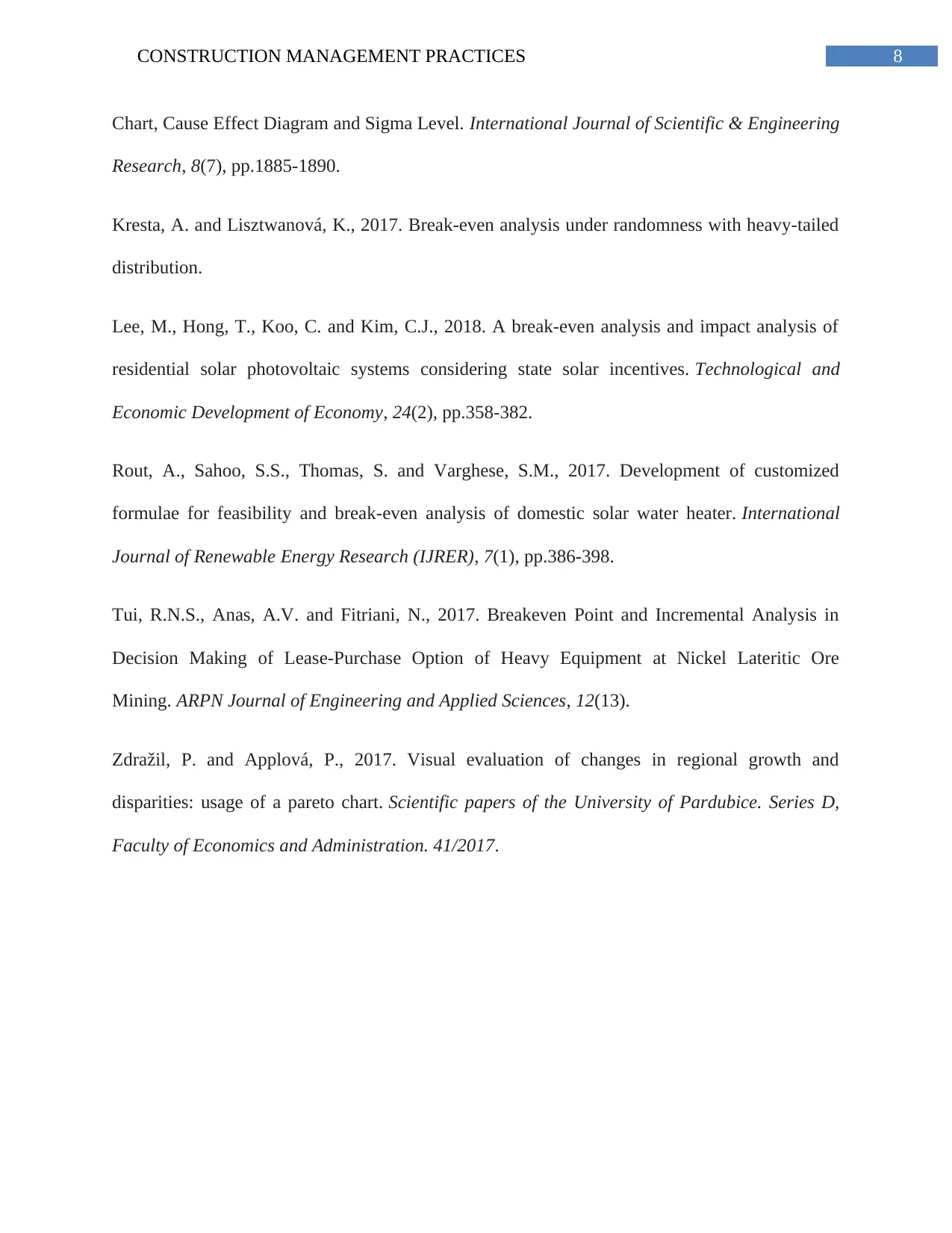
8CONSTRUCTION MANAGEMENT PRACTICES
Chart, Cause Effect Diagram and Sigma Level. International Journal of Scientific & Engineering
Research, 8(7), pp.1885-1890.
Kresta, A. and Lisztwanová, K., 2017. Break-even analysis under randomness with heavy-tailed
distribution.
Lee, M., Hong, T., Koo, C. and Kim, C.J., 2018. A break-even analysis and impact analysis of
residential solar photovoltaic systems considering state solar incentives. Technological and
Economic Development of Economy, 24(2), pp.358-382.
Rout, A., Sahoo, S.S., Thomas, S. and Varghese, S.M., 2017. Development of customized
formulae for feasibility and break-even analysis of domestic solar water heater. International
Journal of Renewable Energy Research (IJRER), 7(1), pp.386-398.
Tui, R.N.S., Anas, A.V. and Fitriani, N., 2017. Breakeven Point and Incremental Analysis in
Decision Making of Lease-Purchase Option of Heavy Equipment at Nickel Lateritic Ore
Mining. ARPN Journal of Engineering and Applied Sciences, 12(13).
Zdražil, P. and Applová, P., 2017. Visual evaluation of changes in regional growth and
disparities: usage of a pareto chart. Scientific papers of the University of Pardubice. Series D,
Faculty of Economics and Administration. 41/2017.
Chart, Cause Effect Diagram and Sigma Level. International Journal of Scientific & Engineering
Research, 8(7), pp.1885-1890.
Kresta, A. and Lisztwanová, K., 2017. Break-even analysis under randomness with heavy-tailed
distribution.
Lee, M., Hong, T., Koo, C. and Kim, C.J., 2018. A break-even analysis and impact analysis of
residential solar photovoltaic systems considering state solar incentives. Technological and
Economic Development of Economy, 24(2), pp.358-382.
Rout, A., Sahoo, S.S., Thomas, S. and Varghese, S.M., 2017. Development of customized
formulae for feasibility and break-even analysis of domestic solar water heater. International
Journal of Renewable Energy Research (IJRER), 7(1), pp.386-398.
Tui, R.N.S., Anas, A.V. and Fitriani, N., 2017. Breakeven Point and Incremental Analysis in
Decision Making of Lease-Purchase Option of Heavy Equipment at Nickel Lateritic Ore
Mining. ARPN Journal of Engineering and Applied Sciences, 12(13).
Zdražil, P. and Applová, P., 2017. Visual evaluation of changes in regional growth and
disparities: usage of a pareto chart. Scientific papers of the University of Pardubice. Series D,
Faculty of Economics and Administration. 41/2017.
⊘ This is a preview!⊘
Do you want full access?
Subscribe today to unlock all pages.

Trusted by 1+ million students worldwide
1 out of 9
Related Documents
Your All-in-One AI-Powered Toolkit for Academic Success.
+13062052269
info@desklib.com
Available 24*7 on WhatsApp / Email
![[object Object]](/_next/static/media/star-bottom.7253800d.svg)
Unlock your academic potential
Copyright © 2020–2025 A2Z Services. All Rights Reserved. Developed and managed by ZUCOL.





